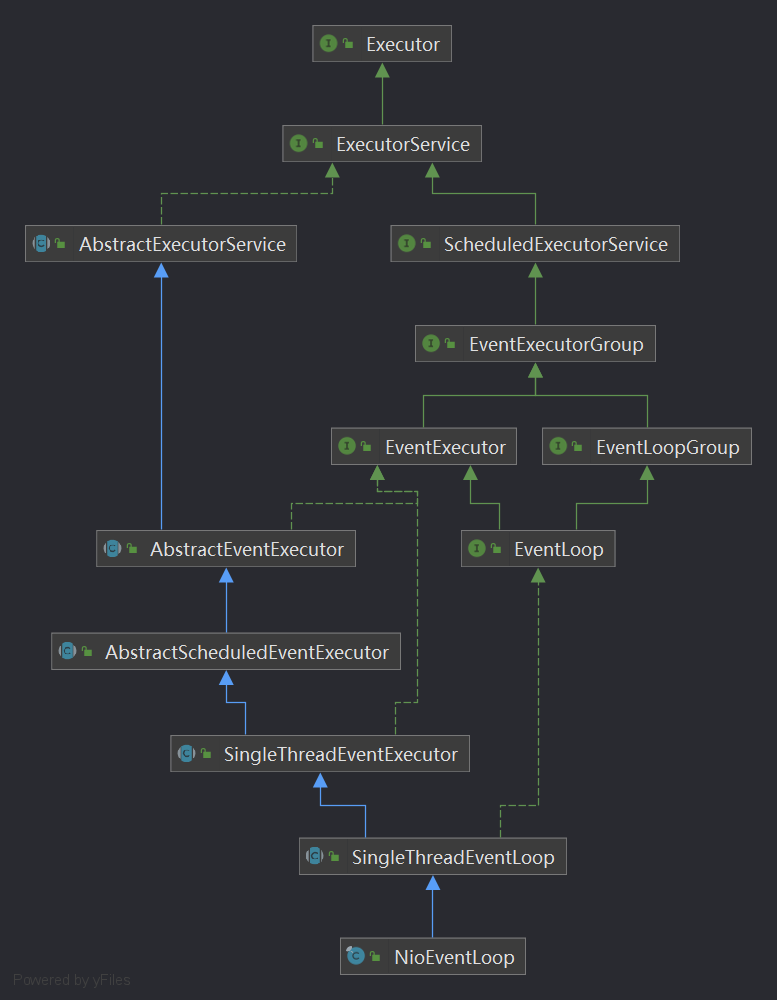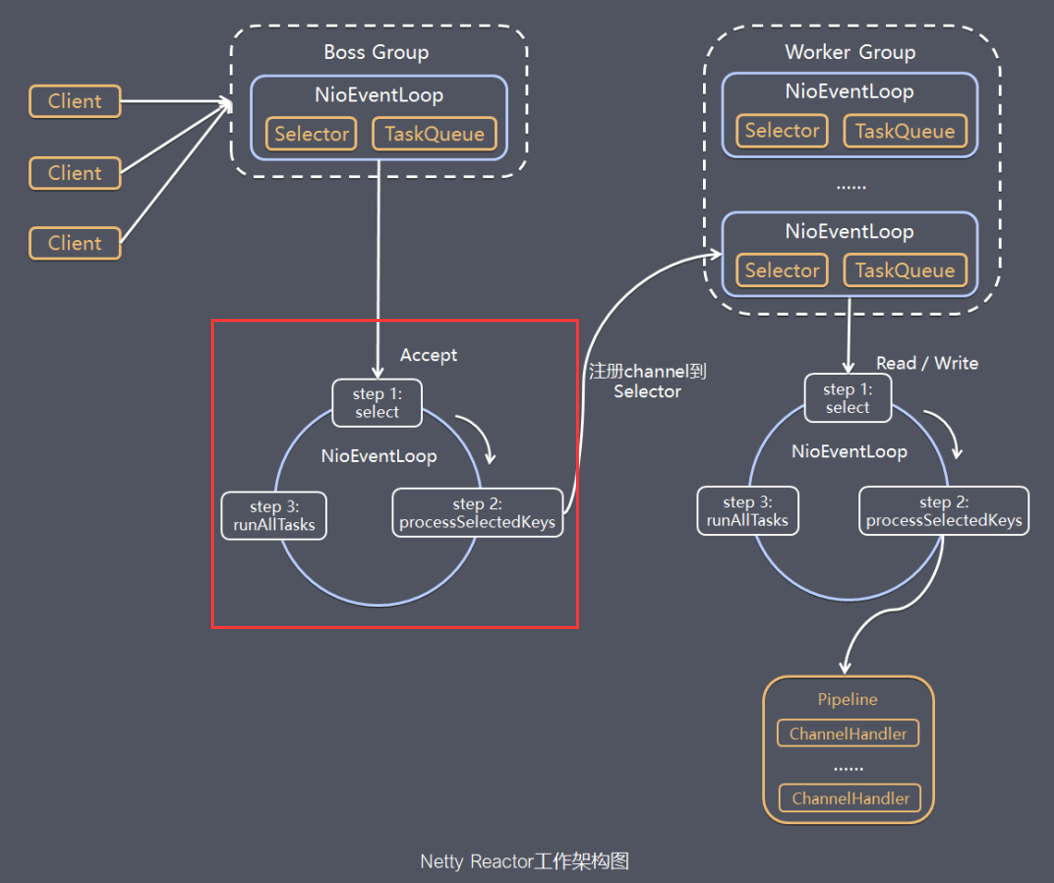Netty源码解读(三)-NioEventLoop
先看看EventLoop类图

我们在Netty第二篇文章中的代码中,看到有多次用到eventLoop.execute()方法,这个方法就是EventLoop开启线程执行任务的关键,跟踪进去看看
// 类SingleThreadEventExecutor
SingleThreadEventExecutor#execute(Runnable task)
-->
SingleThreadEventExecutor#execute0(@Schedule Runnable task)
-->
private void execute(Runnable task, boolean immediate) {
// 判断当前线程是否为eventLoop的线程
boolean inEventLoop = inEventLoop();
// 将任务添加进taskQueue
addTask(task);
if (!inEventLoop) {
// 开启eventLoop的线程
startThread();
if (isShutdown()) {
boolean reject = false;
try {
if (removeTask(task)) {
reject = true;
}
} catch (UnsupportedOperationException e) {
// The task queue does not support removal so the best thing we can do is to just move on and
// hope we will be able to pick-up the task before its completely terminated.
// In worst case we will log on termination.
}
if (reject) {
reject();
}
}
}
if (!addTaskWakesUp && immediate) {
wakeup(inEventLoop);
}
}
这段代码,我们分3部分解读
添加任务
将任务添加进队列,等待调用
对应代码
// addTask(task);
// 类SingleThreadEventExecutor
protected void addTask(Runnable task) {
ObjectUtil.checkNotNull(task, "task");
// 添加任务
if (!offerTask(task)) {
// 如果添加失败,执行拒绝执行处理器
reject(task);
}
}
SingleThreadEventExecutor有一个类变量来存储task
private final Queue<Runnable> taskQueue;
开启线程
开启线程是以下这段逻辑
// 判断当前线程是否eventLoop的线程
// 如果不是,则开启EventLoop的线程
if (!inEventLoop) {
// 开启eventLoop的线程
startThread();
。。。。。。
}
-->
// 类SingleThreadEventExecutor
private void startThread() {
// 一些状态判断,保证doStartThread只会被执行一次
if (state == ST_NOT_STARTED) {
// cas修改状态
if (STATE_UPDATER.compareAndSet(this, ST_NOT_STARTED, ST_STARTED)) {
boolean success = false;
try {
// 实际开启线程的方法
doStartThread();
success = true;
} finally {
if (!success) {
STATE_UPDATER.compareAndSet(this, ST_STARTED, ST_NOT_STARTED);
}
}
}
}
}
-->
// 类SingleThreadEventExecutor
private void doStartThread() {
assert thread == null;
// 这个Executor在EventLoopGroup构造时,就已经注入
// MultithreadEventExecutorGroup
// executor = new ThreadPerTaskExecutor(newDefaultThreadFactory());
executor.execute(new Runnable() {
@Override
public void run() {
thread = Thread.currentThread();
if (interrupted) {
thread.interrupt();
}
boolean success = false;
updateLastExecutionTime();
try {
// 这个整个NioEventLoop的核心,里面是个死循环
SingleThreadEventExecutor.this.run();
success = true;
} catch (Throwable t) {
logger.warn("Unexpected exception from an event executor: ", t);
} finally {
。。。。。。
}
}
});
}
在前面EventLoopGroup的创建与初始化一节有说到,executor的实例化
executor = new ThreadPerTaskExecutor(newDefaultThreadFactory());
executor.execute(new Runnable() {...});
// 不深究细节的话,上面两行代码效果类比下面两行
Thread thread = new Thread(new Runnable() {...});
thread.start();
所以,executor.execute这里,就开了一个新的线程。
而这个线程,主要处理的是SingleThreadEventExecutor.**this**.run();,也就是NioEventLoop#run()
那这个run方法是干嘛的,看下图红框部分

因为run方法比较重要,此处不做代码省略,看注释
protected void run() {
int selectCnt = 0;
for (;;) {
try {
int strategy;
try {
// 如果没有任务,则返回SELECT
// 有任务,则获取io事件的个数。此时如果strategy >= 0
// 如果有io任务,优先io任务,然后才执行普通任务
strategy = selectStrategy.calculateStrategy(selectNowSupplier, hasTasks());
switch (strategy) {
case SelectStrategy.CONTINUE:
continue;
case SelectStrategy.BUSY_WAIT:
// fall-through to SELECT since the busy-wait is not supported with NIO
case SelectStrategy.SELECT:
// 下一次定时任务触发截止时间
long curDeadlineNanos = nextScheduledTaskDeadlineNanos();
if (curDeadlineNanos == -1L) {
curDeadlineNanos = NONE; // nothing on the calendar
}
nextWakeupNanos.set(curDeadlineNanos);
try {
// 再次判断没有任务
if (!hasTasks()) {
strategy = select(curDeadlineNanos);
}
} finally {
// This update is just to help block unnecessary selector wakeups
// so use of lazySet is ok (no race condition)
// 阻止不必要的唤醒
nextWakeupNanos.lazySet(AWAKE);
}
// fall through
default:
}
} catch (IOException e) {
// If we receive an IOException here its because the Selector is messed up. Let's rebuild
// the selector and retry. https://github.com/netty/netty/issues/8566
rebuildSelector0();
selectCnt = 0;
handleLoopException(e);
continue;
}
selectCnt++;
cancelledKeys = 0;
needsToSelectAgain = false;
// 控制处理io事件的事件占用比例,默认是百分之50,一半时间用来处理io事件,一半时间用来处理任务
final int ioRatio = this.ioRatio;
boolean ranTasks;
// 100%表示执行完全部任务,才进入下一轮循环
if (ioRatio == 100) {
try {
if (strategy > 0) {
// 在对应的 Channel 上处理 IO 事件
processSelectedKeys();
}
} finally {
// Ensure we always run tasks.
// 执行queueTask中全部的任务
ranTasks = runAllTasks();
}
} else if (strategy > 0) {
final long ioStartTime = System.nanoTime();
try {
// 在对应的 Channel 上处理 IO 事件
processSelectedKeys();
} finally {
// Ensure we always run tasks.
final long ioTime = System.nanoTime() - ioStartTime;
ranTasks = runAllTasks(ioTime * (100 - ioRatio) / ioRatio);
}
} else {
// 0表示运行运行最小数量的任务,即63个
ranTasks = runAllTasks(0); // This will run the minimum number of tasks
}
if (ranTasks || strategy > 0) {
if (selectCnt > MIN_PREMATURE_SELECTOR_RETURNS && logger.isDebugEnabled()) {
logger.debug("Selector.select() returned prematurely {} times in a row for Selector {}.",
selectCnt - 1, selector);
}
selectCnt = 0;
} else if (unexpectedSelectorWakeup(selectCnt)) { // Unexpected wakeup (unusual case)
selectCnt = 0;
}
} catch (CancelledKeyException e) {
// Harmless exception - log anyway
if (logger.isDebugEnabled()) {
logger.debug(CancelledKeyException.class.getSimpleName() + " raised by a Selector {} - JDK bug?",
selector, e);
}
} catch (Error e) {
throw e;
} catch (Throwable t) {
handleLoopException(t);
} finally {
// Always handle shutdown even if the loop processing threw an exception.
try {
if (isShuttingDown()) {
closeAll();
if (confirmShutdown()) {
return;
}
}
} catch (Error e) {
throw e;
} catch (Throwable t) {
handleLoopException(t);
}
}
}
}
run里面是个死循环,关键方法有select、processSelectedKeys、runAllTasks
select
select方法很简单,就是选择合适的阻塞时间,等待IO事件触发
private int select(long deadlineNanos) throws IOException {
if (deadlineNanos == NONE) {
return selector.select();
}
// Timeout will only be 0 if deadline is within 5 microsecs
// 如果deadlineNanos小于5纳秒,则为0,,否则取整为1毫秒
// 这段操作是为了向上取整,转成毫秒
long timeoutMillis = deadlineToDelayNanos(deadlineNanos + 995000L) / 1000000L;
// 如果timeoutMillis大于0,就阻塞selector同样的时间
// 这段是为了获取最近的延时任务
return timeoutMillis <= 0 ? selector.selectNow() : selector.select(timeoutMillis);
}
runAllTasks
此方法会取出可执行的任务,并执行。
上一节添加任务讲的addTask,放入的任务就是在这里被执行的。
processSelectedKeys
此方法在有IO事件时才触发,这个下面细讲
小结一下,run的死循环中主要判断有无IO事件,有则处理,处理完IO事件,再处理队列中的任务。
如果没有IO事件,也没有待处理的任务,则阻塞等待。
唤醒线程
对应代码
// wakeup(inEventLoop);
// 类NioEventLoop
protected void wakeup(boolean inEventLoop) {
// 不是当前EventLoop在执行的时候,才需要唤醒
// nextWakeupNanos放入AWAKE是阻止不必要的唤醒
if (!inEventLoop && nextWakeupNanos.getAndSet(AWAKE) != AWAKE) {
selector.wakeup();
}
}
阻塞是selecto.select,那么唤醒就是selector.wakeup
Netty源码解读(三)-NioEventLoop的更多相关文章
- Netty源码分析之NioEventLoop(三)—NioEventLoop的执行
前面两篇文章Netty源码分析之NioEventLoop(一)—NioEventLoop的创建与Netty源码分析之NioEventLoop(二)—NioEventLoop的启动中我们对NioEven ...
- 【Netty源码解析】NioEventLoop
上一篇博客[Netty源码学习]EventLoopGroup中我们介绍了EventLoopGroup,实际说来EventLoopGroup是EventLoop的一个集合,EventLoop是一个单线程 ...
- go语言 nsq源码解读三 nsqlookupd源码nsqlookupd.go
从本节开始,将逐步阅读nsq各模块的代码. 读一份代码,我的思路一般是: 1.了解用法,知道了怎么使用,对理解代码有宏观上有很大帮助. 2.了解各大模块的功能特点,同时再想想,如果让自己来实现这些模块 ...
- Netty源码解读(二)-服务端源码讲解
简单Echo案例 注释版代码地址:netty 代码是netty的源码,我添加了自己理解的中文注释. 了解了Netty的线程模型和组件之后,我们先看看如何写一个简单的Echo案例,后续的源码讲解都基于此 ...
- Netty源码分析之NioEventLoop(二)—NioEventLoop的启动
上篇文章中我们对Netty中NioEventLoop创建流程与源码进行了跟踪分析.本篇文章中我们接着分析NioEventLoop的启动流程: Netty中会在服务端启动和新连接接入时通过chooser ...
- Netty源码解读(四)-读写数据
读写Channel(READ)的创建和注册 在NioEventLoop#run中提到,当有IO事件时,会调用processSelectedKeys方法来处理. 当客户端连接服务端,会触发服务端的ACC ...
- Netty源码解读(一)-前置准备
前置条件 源码版本netty4.1 了解Java NIO.Reactor模型和Netty的基本使用. 解释一下: Java NIO:了解BIO和NIO的区别以及Java NIO基础API的使用 Rea ...
- jQuery源码解读三选择器
直接上jQuery源码截取代码 // Map over jQuery in case of overwrite _jQuery = window.jQuery, // Map over the $ i ...
- Python Web Flask源码解读(三)——模板渲染过程
关于我 一个有思想的程序猿,终身学习实践者,目前在一个创业团队任team lead,技术栈涉及Android.Python.Java和Go,这个也是我们团队的主要技术栈. Github:https:/ ...
随机推荐
- QY-16 浮标水质监测站 组成 及基础参数是什么?一文认识什么是浮标水质监测站
浮标水质监测站是设立在河流.湖泊.水库.近岸海域等流 域内的现场水质自动监测实验室,是以水质监测仪为核心,运用 传感器技术,结合浮标体.电源供电系统.数据传输设备组成的 放置于水域内的小型水质监测系统 ...
- 559. Maximum Depth of N-ary Tree - LeetCode
Question 559. Maximum Depth of N-ary Tree Solution 题目大意:N叉树求最大深度 思路:用递归做,树的深度 = 1 + 子树最大深度 Java实现: / ...
- 142_Power BI之同比预测
博客:www.jiaopengzi.com 焦棚子的文章目录 请点击下载附件 一.背景 最近刚好在做一个简单同比预测的模型,预测方法很简单,就是累计同比预测,把MTD展示出来. [video widt ...
- 基于 BaGet 搭建 Nuget 服务器
1 前言 1.1 BaGet 介绍 BaGet 是一个轻量级的,开源的,跨平台的 Nuget 和 symbol 服务器. 1.2 环境介绍 操作系统:CentOS 7 使用 Docker 安装 2 安 ...
- Dockerfile 使用 SSH
如果在书写 Dockerfile 时,有些命令需要使用到 SSH 连接,比如从私有仓库下载文件等,那么我们应该怎么做呢? Dockerfile 使用 SSH Dockerfile 文件配置 为了使得 ...
- 【FineBI】FineBI连接阿里云mysql教程
因为某些原因需要查看数据信息,之前连接成功一次,今天软件更新了以后发现连接信息丢. 又重新折腾了一下. 主要有2个地方: 1.查看阿里云数据库外网连接地址:打开云数据库RDS-实例列表-管理-数据库连 ...
- vue跑马灯vue3-marquee
安装vue3-marquee 如果您使用的是 npm: npm install vue3-marquee@latest --save 如果您使用的是yarn: yarn add vue3-marque ...
- 腾讯云数据库TDSQL-大咖论道 | 基础软件的过去、现在、未来
近十年来,中国基础软件发展势头迅猛,市场前景看高,越来越多的企业也正在进行基础软件升级.那中国基础软件行业目前在国际市场上有什么优势,面临哪些困境,以及未来基础软件行业会如何发展呢?腾讯云数据库邀请沙 ...
- python爬虫之JS逆向某易云音乐
Python爬虫之JS逆向采集某易云音乐网站 在获取音乐的详情信息时,遇到请求参数全为加密的情况,现解解决方案整理如下: JS逆向有两种思路: 一种是整理出js文件在Python中直接使用execjs ...
- 【Spring】AOP实现原理(一):AOP基础知识
AOP相关概念 在学习AOP实现原理之前,先了解下AOP相关基础知识. AOP面向切面编程,它可以通过预编译方式或者基于动态代理对我们编写的代码进行拦截(也叫增强处理),在方法执行前后可以做一些操作, ...
